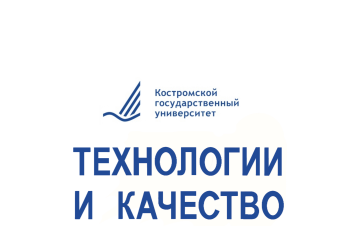- 6
- COMBINED FILAMENTS WITH A FERROMAGNETIC ROD, THEIR STRUCTURE AND PROSPECTS FOR USE
- Boyko S. Yu., Fefelova T. L., Trifonova L. B., Sokova G. G., Rudovsky P. N. Combined fila- ments with a ferromagnetic rod, their structure and prospects for use. Technologies & Quality. 2023. No 2(60). P. 30–35. (In Russ.) https://doi.org/10.34216/2587-6147-2023-2-60-30-35.
- DOI: https://doi.org/10.34216/2587-6147-2023-2-60-30-35
- УДК: 677.054.847.82
- EDN: TOKAAU
- Publish date: 2023-05-10
- Annotation: The paper analyzes the existing methods for obtaining threads and yarns. It has been established that the largest combined (reinforced) threads make it possible to produce textile products with specified special properties. Tensile tests were carried out on a combined three-component yarn, one of the components of which was a ferromagnetic microwire. It has been established that when such a thread is stretched, the breakage of the components does not occur simultaneously. First of all, the component with the highest rigidity, the ferromagnetic microwire, is torn. The breaking elongation of the microwire is practically equal to the deformation of the warp thread during weaving on shuttleless looms. Therefore, for a stable weaving process, it is necessary to select the appropriate technological modes, or to develop threads of a special structure with increased breaking elongation.
- Keywords: spinning methods, innovative textile materials, strength, tear, elongation at break, combined yarns, ferromagnetic microwire, electromagnetic radiation
- Literature list: 1. Rudovsky P. N., Belova I. S. Analysis and prospects of adhesive methods of yarn formation. Analiz i perspektivy kleevyh sposobov formirovaniya pryazhi [Physics of fibrous materials: structure, properties, high technologies and materials (SMARTEX)]. 2019;1-1:186–189. (In Russ.) 2. Ryklin D. B., Kogan A. G. Production of multicomponent yarns and combined threads. Monograph. Vitebsk, St. technol. Univ. of Vitebsk Publ. 2002. 215 p. (In Russ.) 3. Ferromagnetic microwire in glass insulation. CKB RM : official website. URL: https://ckbrm.ru/index.php?products=55. (Accessed: 11/23/2022.). 4. Fefelova T. L., Trifonova L. B., Sokova G. G., Boyko S. Yu. Analysis of textile materials used for protection against electromagnetic radiation. Tekhnologii i kachestvo [Technologies & Quality]. 2022;3(57):30–33. (In Russ.) 5. Palochkin S. V., Rudovsky M. P., Rudovsky P. N. Storage device for heat treatment of self-twisted combined yarns with elastane. Monograph. Moscow, Kosygin Rus. St. Univ. Publ., 2008. 181 p. (In Russ.) 6. Rudovsky M.P., Palochkin S.V., Rudovsky P.N. Investigation of the influence of the elastic properties of combined threads on the technological parameters of the accumulator. Izvestiya Vysshikh Uchebnykh Zavedenii. Seriya Teknologiya Tekstil'noi Promyshlennosti [Textile Industry Technology (Series Proceedings of Higher Educational Institutions)] 2009;2(314):6-8. (In Russ.) 7. Kiselev A. M., Rudovsky P. N., Kiselev M. V., Ishmatov A. B. Modeling of breaking load of spun natural silk threads by numerical methods. Izvestiya Vysshikh Uchebnykh Zavedenii. Seriya Teknologiya Tekstil'noi Promyshlennosti [Textile Industry Technology (Series Proceedings of Higher Educational Institu- tions)]. 2013;4(346):38–41. (In Russ.) 8. Sokova G. G. Remote study of tissue as an equivalent of standard methods for determining its quality indicators. Standarty i kachestvo [Standards and Quality]. 2008.;3:70–71. (In Russ.) 9. Nazarova M. V., Romanov V. Yu. Evaluation of the tension of filling a loom in the manufacture of fabrics of various weaves. Izvestiya Vysshikh Uchebnykh Zavedenii. Seriya Teknologiya Tekstil'noi Promyshlennosti [Textile Industry Technology (Series Proceedings of Higher Educational Institutions)]. 2013;2:63–67. (In Russ.)



